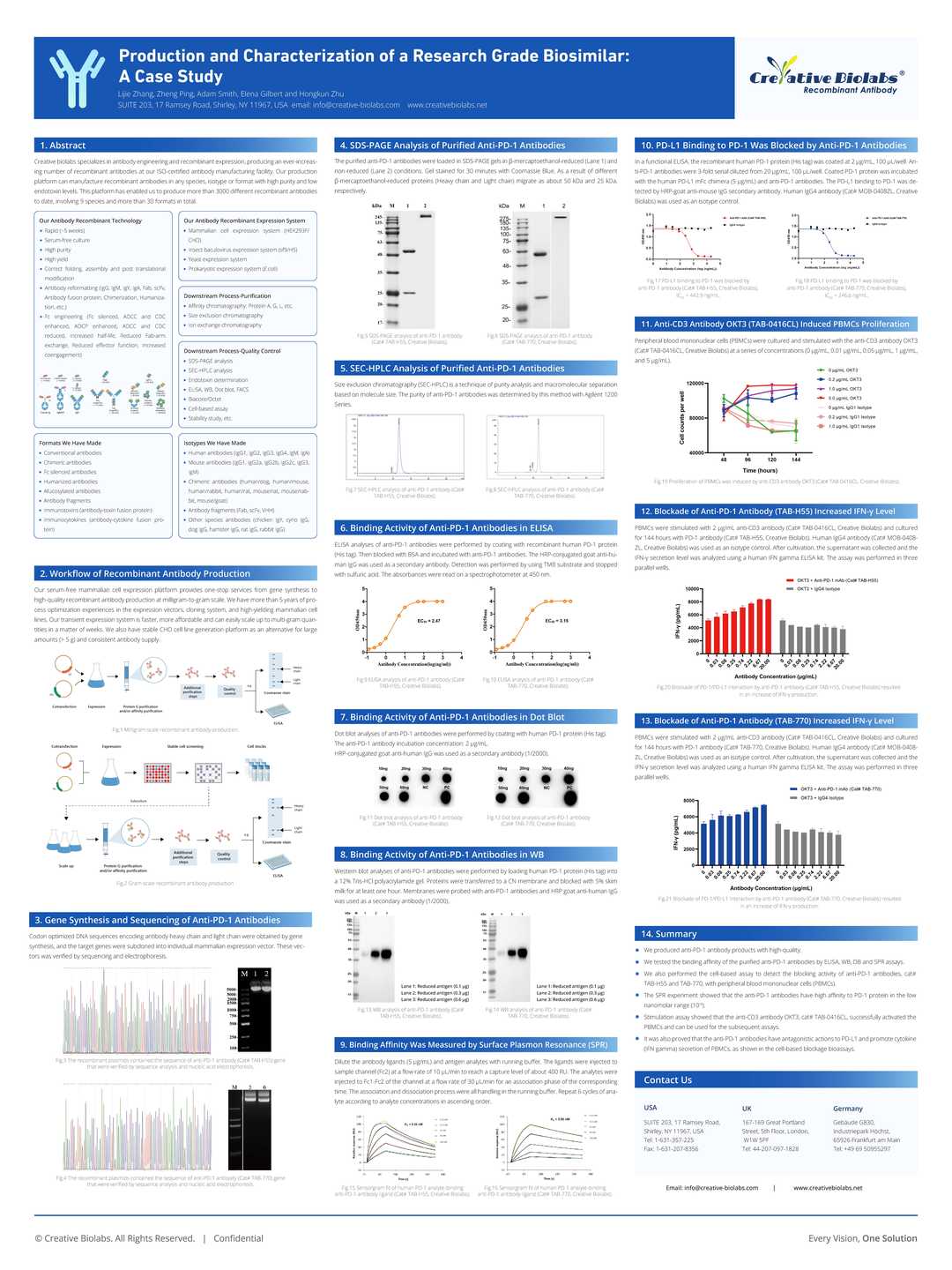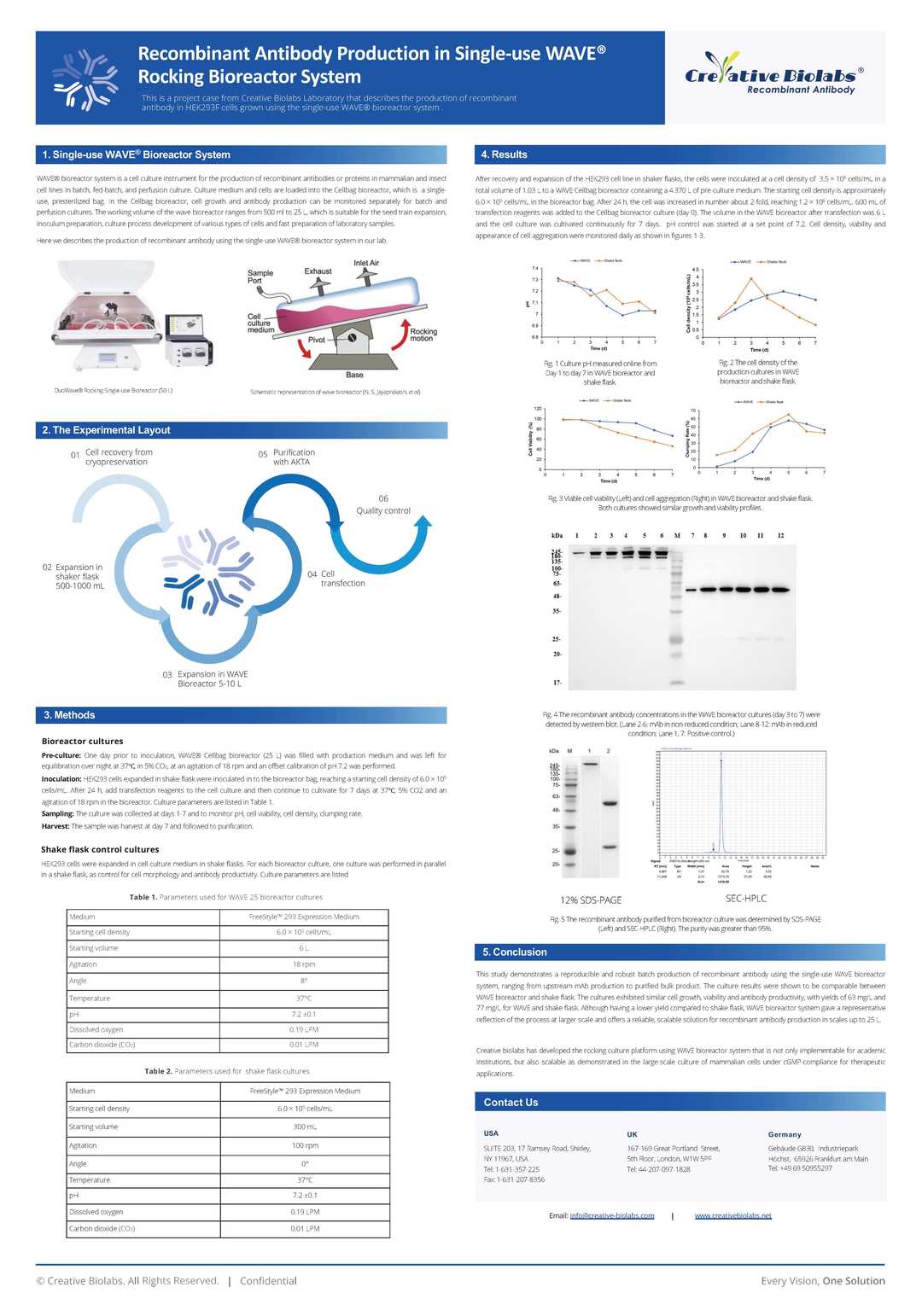Recombinant Human Anti-RSV Antibody (D25)
CAT#: PABL-322
Recombinant Human Antibody (D25) is capable of binding to RSV, expressed in HEK 293 cells. Expressed as the combination of a heavy chain (HC) containing VH from anti-RSV mAb and CH1-3 region of human IgG1 and a light chain (LC) encoding VL from anti-RSV mAb and CL of human kappa light chain. Exists as a disulfide linked dimer of the HC and LC hetero-dimer under non-reducing condition.

















Specifications
- Immunogen
- The details of the immunogen for this antibody are not available.
- Host Species
- Human
- Derivation
- Human
- Type
- IgG
- Specificity
- Tested positive against native RSV
- Species Reactivity
- RSV
- Clone
- D25
- Applications
- WB, ELISA, Neut, FuncS
Product Property
- Purity
- >95% by SDS-PAGE and HPLC analysis
- Storage
- Store the antibody (in aliquots) at -20°C. Avoid repeated freezing and thawing of samples.
Applications
- Application Notes
- The antibody was validated for Neutralization, ELISA and Function Assay. For details, refer to Published Data.
Target
- Alternative Names
- RSV; Human respiratory syncytial virus
Customer Review
There are currently no Customer reviews or questions for PABL-322. Click the button above to contact us or submit your feedback about this product.
 Jessica Hill
Jessica Hill David Adams
David Adams Megan Martinez
Megan Martinez User 193*****49
User 193*****49Q&As
-
Is the anti-RSV antibody suitable for use in Western blotting?
A: Yes, the anti-RSV antibody (PABL-322) is suitable for use in Western blotting. It provides specific binding to the RSV protein, allowing for reliable detection in Western blot assays.
-
What are the storage recommendations for the anti-RSV antibody?
A: The recommended storage condition for the anti-RSV antibody (PABL-322) is at -20°C or lower. For short-term storage, it can be kept at 2-8°C. To ensure stability, avoid repeated freeze-thaw cycles.
-
Can the anti-RSV antibody be used in immunoprecipitation assays?
A: Yes, the anti-RSV antibody (PABL-322) can be used in immunoprecipitation assays. It provides specific binding to the RSV protein, enabling the successful precipitation of the target protein from complex mixtures.
-
Is the anti-RSV antibody effective in ELISA applications?
A: Yes, the anti-RSV antibody (PABL-322) is effective in ELISA applications. It has been validated for use in such assays and provides reliable detection of the RSV protein.
-
What is the optimal dilution for using the anti-RSV antibody in immunofluorescence?
A: The optimal dilution for using the anti-RSV antibody (PABL-322) in immunofluorescence is typically 1:100 to 1:500. It is advisable to perform a dilution series to determine the best working concentration for your specific experimental conditions.
View the frequently asked questions answered by Creative Biolabs Support.
Citations
-
Tang, Wei, et al. "Mechanism of cross-resistance to fusion inhibitors conferred by the K394R mutation in respiratory syncytial virus fusion protein." Journal of Virology 95.20 (2021): 10-1128. https://doi.org/10.1128/jvi.01205-21This study investigates the mechanism of cross-resistance to fusion inhibitors conferred by the K394R mutation in the respiratory syncytial virus (RSV) fusion protein. The researchers employed a dual-luciferase protocol to discover LF-6, a small-molecule inhibitor that targets the RSV fusion glycoprotein. They found that the K394R mutation not only conferred resistance to LF-6 but also to other RSV fusion inhibitors, including those in clinical development. This mutation destabilizes the F protein and enhances its membrane fusion activity, increasing viral resistance. The study highlights the need for alternative strategies to combat RSV infections, given the resistance risks posed by the K394R mutation.
In this research, Creative Biolabs provided crucial reagents that facilitated the experiments. Specifically, the D25 monoclonal antibody (Cat# PABL-322) and Motavizumab (Cat# TAB-709) were used for detecting RSV F protein in various assays, including the immunofluorescence and cell-surface triggering assays. These antibodies were essential for accurately identifying the effects of mutations on the RSV F protein and assessing the resistance mechanisms. The products from Creative Biolabs significantly contributed to the detailed analysis and validation of the findings related to the K394R mutation and its impact on RSV fusion inhibitor resistance. -
Gilbert, Brian E., et al. "Respiratory syncytial virus fusion nanoparticle vaccine immune responses target multiple neutralizing epitopes that contribute to protection against wild-type and palivizumab-resistant mutant virus challenge." Vaccine 36.52 (2018): 8069-8078. https://doi.org/10.1016/j.vaccine.2018.10.073This study focused on the development and evaluation of an RSV F nanoparticle vaccine targeting human respiratory syncytial virus (RSV), which is a major cause of severe respiratory infections in various vulnerable populations, including newborns and the elderly. The RSV F nanoparticle vaccine was designed to induce a broad polyclonal antibody response against multiple neutralizing epitopes on the fusion (F) protein of RSV. These antibodies were shown to neutralize both wild-type RSV and palivizumab-resistant mutant strains in animal models, particularly in cotton rats. The vaccine's efficacy was enhanced with the use of an aluminum phosphate adjuvant, which significantly increased the antibody avidity and protection against RSV challenges.
Creative Biolabs contributed to this study by providing the monoclonal antibody D25 (Cat#: PABL-322), which was used for competitive binding assays to characterize the antibody responses elicited by the RSV F nanoparticle vaccine. The D25 antibody specifically targets antigenic site Ø on the pre-fusion F conformation of the RSV F protein. The inclusion of this antibody was crucial for demonstrating that the vaccine-induced antibodies could bind to conserved epitopes on both pre-fusion and post-fusion F conformations, supporting the vaccine's potential to provide broad protection against RSV. -
Lee, Youri, et al. "The efficacy of inactivated split respiratory syncytial virus as a vaccine candidate and the effects of novel combination adjuvants." Antiviral research 168 (2019): 100-108. https://doi.org/10.1016/j.antiviral.2019.05.011This study investigates the efficacy of inactivated split respiratory syncytial virus (RSV) as a vaccine candidate compared to traditional formalin-inactivated RSV (FI-RSV). The research demonstrates that split RSV, created by treating FI-RSV with detergent, displays higher reactivity against neutralizing antibodies in vitro and causes less histopathology in mice after challenge. Furthermore, when combined with monophosphoryl lipid A (MPL) and CpG adjuvants, the split RSV vaccine effectively increases T helper type 1 immune responses, enhances IgG2a isotype antibodies and neutralizing activity, promotes lung viral clearance, and prevents pulmonary histopathology after vaccination and challenge in a two-week-old mouse model.
Creative Biolabs provided the D25 monoclonal antibody that specifically recognizes the pre-fusion conformation of the RSV F protein. This antibody was crucial for analyzing the antigenic properties of the split RSV vaccine, enabling researchers to demonstrate that detergent treatment enhanced the exposure of neutralizing epitopes. These findings provided a mechanistic explanation for the improved efficacy and reduced pathology of the split RSV vaccine formulation, potentially advancing the development of safer and more effective RSV vaccines.
Cite This Product
To accurately reference this product in your publication, please use the following citation information:
(Creative Biolabs Cat# PABL-322, RRID: AB_3111649)
Submit Your Publication
Published with our product? Submit your paper and receive a 10% discount on your next order! Share your research to earn exclusive rewards.
Publications
Peer-reviewed PublicationsOur products have been used extensively by scientists all over the world to accelerate their life science research. Here, we present a collection of publications that cite this product.
Gilbert, Brian E., et al. "Respiratory syncytial virus fusion nanoparticle vaccine immune responses target multiple neutralizing epitopes that contribute to protection against wild-type and palivizumab-resistant mutant virus challenge." Vaccine 36.52 (2018): 8069-8078.
Lee, Youri, et al. "The efficacy of inactivated split respiratory syncytial virus as a vaccine candidate and the effects of novel combination adjuvants." Antiviral research (2019)
Downloadable Resources
Download resources about recombinant antibody development and antibody engineering to boost your research.
Product Notes
This is a product of Creative Biolabs' Hi-Affi™ recombinant antibody portfolio, which has several benefits including:
• Increased sensitivity
• Confirmed specificity
• High repeatability
• Excellent batch-to-batch consistency
• Sustainable supply
• Animal-free production
See more details about Hi-Affi™ recombinant antibody benefits.
Datasheet
MSDS
COA
Certificate of Analysis LookupTo download a Certificate of Analysis, please enter a lot number in the search box below. Note: Certificate of Analysis not available for kit components.
See other products for "Clone D25"
- CAT
- Product Name
See other products for "RSV"
Select a product category from the dropdown menu below to view related products.
| CAT | Product Name | Application | Type |
|---|---|---|---|
| TAB-098 | Anti-RSV Recombinant Antibody (TAB-098) | IF, IP, Neut, FuncS, ELISA, FC, ICC | IgG1 - kappa |
| CAT | Product Name | Application | Type |
|---|---|---|---|
| TAB-538CL | Human Anti-RSV Recombinant Antibody (TAB-538CL) | ELISA | Human IgG |
| CAT | Product Name | Application | Type |
|---|---|---|---|
| MRO-1300CQ | Recombinant Mouse Anti-RSV Antibody (2017/84) | ELISA, WB | Mouse antibody |
| MRO-1301CQ | Recombinant Mouse Anti-RSV Antibody (2F7) | WB, IF, ELISA | Mouse antibody |
| MRO-1302CQ | Recombinant Mouse Anti-RSV Antibody (MRO-1302CQ) | IF, IHC | Mouse antibody |
| HPAB-0363LY | Recombinant Humanized Anti-RSV Antibody (1308F) | Neutralization, ELISA | |
| HPAB-1412-FY | Recombinant Anti-RSV Antibody (824) | Neut |
| CAT | Product Name | Application | Type |
|---|---|---|---|
| MRO-824LC | Anti-RSV Recombinant Antibody (HNK11) | ELISA | Mouse antibody |
| MRO-825LC | Anti-RSV Recombinant Antibody (HNK19) | ELISA | Mouse antibody |
| MRO-826LC | Anti-RSV Recombinant Antibody (HNK20) | ELISA | Mouse antibody |
| MRO-827LC | Anti-RSV Recombinant Antibody (HNK22) | ELISA | Mouse antibody |
| MRO-828LC | Anti-RSV Recombinant Antibody (HNK24) | ELISA | Mouse antibody |
| CAT | Product Name | Application | Type |
|---|---|---|---|
| MOR-4397 | Hi-Affi™ Recombinant Rabbit Anti-RSV Monoclonal Antibody (SI488DS) | Neut | IgG |
| MOR-4398 | Hi-Affi™ Recombinant Rabbit Anti-RSV Monoclonal Antibody (SI489DS) | ELISA, FC, ICC, IF, IF | IgG |
| CAT | Product Name | Application | Type |
|---|---|---|---|
| FAMAB-0114-CN-S(P) | Recombinant Humanized Anti-RSV Antibody scFv Fragment (HuRSV19) | ELISA, BL | Humanized scFv |
| HPAB-1412-FY-F(E) | Recombinant Anti-RSV Antibody scFv Fragment (824) | Neut | Human scFv |
| HPAB-1413-FY-F(E) | Recombinant Anti-RSV Antibody scFv Fragment (735) | Neut | Human scFv |
| HPAB-1414-FY-F(E) | Recombinant Anti-RSV Antibody scFv Fragment (804) | Neut | Human scFv |
| HPAB-0892-WJ-S(P) | Human Anti-RSV Recombinant Antibody; scFv Fragment (HPAB-0892-WJ-S(P)) | ELISA, WB | Human scFv |
| CAT | Product Name | Application | Type |
|---|---|---|---|
| FAMAB-0114-CN-F(E) | Recombinant Humanized Anti-RSV Antibody Fab Fragment (HuRSV19) | ELISA, BL | Humanized Fab |
| HPAB-2527LY-F(E) | Human Anti-RSV Recombinant Antibody (clone mab2); Fab Fragment | ELISA | Human Fab |
| HPAB-2528LY-F(E) | Human Anti-RSV Recombinant Antibody (clone mab27); Fab Fragment | ELISA | Human Fab |
| HPAB-2529LY-F(E) | Human Anti-RSV Recombinant Antibody (clone mab30); Fab Fragment | ELISA | Human Fab |
| HPAB-2530LY-F(E) | Human Anti-RSV Recombinant Antibody; Fab Fragment (HPAB-2530LY-F(E)) | ELISA | Human Fab |
| CAT | Product Name | Application | Type |
|---|---|---|---|
| AFC-TAB-098 | Afuco™ Anti-RSV ADCC Recombinant Antibody, ADCC Enhanced (AFC-TAB-098) | IF, IP, Neut, FuncS, ELISA, FC | ADCC enhanced antibody |
| CAT | Product Name | Application | Type |
|---|---|---|---|
| VS-0425-FY174 | Human Anti-RSV scFv-Fc Chimera (VS-0425-FY174) | Neut, WB, ELISA, DB | Human IgG1, scFv-Fc |
Popular Products

Application: ELISA, IP, FC, FuncS, Neut, IF, ICC
-2.png)
Application: FuncS, IF, Neut, ELISA, FC, IP, ICC

Application: IF, IP, Neut, FuncS, ELISA, FC, ICC

Application: WB, FuncS, IF, Neut, ELISA, FC, IP

Application: FC, IP, ELISA, Neut, FuncS, IF, ICC

Application: WB, IHC, FC, Cyt, ELISA
-CB2006C17L-4.jpg)
Application: WB, ELISA

Application: ELISA, FC, WB, Block

Application: WB, ELISA, Neut, FuncS

Application: ELISA, IHC, IF, IP, FC, FuncS

Application: ELISA, FuncS, RIA, IP, IF, IHC, IA, Block
For research use only. Not intended for any clinical use. No products from Creative Biolabs may be resold, modified for resale or used to manufacture commercial products without prior written approval from Creative Biolabs.
This site is protected by reCAPTCHA and the Google Privacy Policy and Terms of Service apply.

































